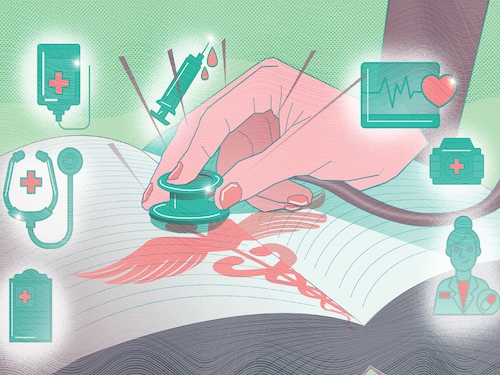Why India's medical education system needs a rethink
India needs systems thinking in its curriculum to train doctors to grow beyond their medical roles and expertise


India’s doctors have long been more than just clinicians—they are called upon to play numerous roles: Leading hospitals, health and research programmes, managing administration and finance, and working with policymakers. As these roles grow in complexity, they demand competencies that go beyond clinical skills, which are still the dominant focus of most medical curricula.
As health systems grow in scale and complexity, so too must medical education. The National Health Policy (2017) calls for reorienting medical education to build system-aware, socially accountable professionals. Niti Aayog’s Vision 2047 strategy echoes this with a call for “next-generation health care leadership” capable of managing complex systems. To translate this vision into reality, medical training must look beyond conventional boundaries.
However, most medical graduates today are underprepared for the systemic challenges they encounter, from workforce shortages and shifting disease burdens to digital disruption and persistent gaps in care. While the existing medical curriculum builds strong clinical competence, it offers little structured exposure to how health systems function or how they can be improved. As a result, doctors are often left to navigate ‘wicked’ problems—issues with no clear cause or linear solution—without the conceptual tools to address them effectively.
Systems thinking is a recognised discipline for understanding complex challenges, such as climate change and public health. It helps uncover patterns, root causes and feedback loops that shape outcomes over time. The field gained prominence through Jay Forrester at MIT, whose system dynamics showed why intuitive solutions often fail in complex systems.
Donella Meadows, another pioneer, extended these ideas to climate and sustainability in her influential 1972 book Limits to Growth. She also developed a ‘leverage points’ framework—ranking ways to intervene in systems—from modifying structures to shifting mindsets.
Also read: How private equity is fuelling the transformation of health care in India
Unlike linear thinking, which often leads to short-term fixes, systems thinking uses analytical tools like stakeholder mapping, causal loop diagrams, and behaviour-over-time graphs, thus helping uncover deeper connections and design smarter interventions. In global health, systems thinking is influencing how policies and programmes are designed. A 2009 World Health Organization report, Systems Thinking for Health Systems Strengthening, offered practical steps addressing interactions between six ‘building blocks’ of health systems. Many experts view systems thinking as one of four key revolutions reshaping health care, alongside advances in life sciences, digital innovation and equity.
In India, systems thinking is already informing public health practice, often through small but powerful projects. It also played a role during the Covid-19 pandemic, guiding complex interventions like lockdowns. In Sitamarhi, Bihar, district hospital teams are engaging in reflective practice to rediscover purpose, build shared responsibility, and strengthen team cohesion. In filariasis-endemic blocks of Bihar and Jharkhand, communities have co-designed interventions that build trust, foster local ownership, and improve uptake, thus contributing to improved coverage during recent Mass Drug Administration (MDA) rounds. Ahmedabad’s ‘One Health’ pilot, which connected human, animal, and environmental health systems to tackle antimicrobial resistance, further shows how intersectoral thinking can unlock powerful new pathways. Together, they illustrate the growing potential of systems thinking to strengthen health systems from the ground up.

A meaningful systems revolution depends on expansion of practitioners’ network through deliberate nurturing, training and exposure. India urgently needs more professionals who can apply systems thinking in diverse health contexts. A natural starting point is medical education. The undergraduate medical curriculum is already shifting towards a competency-based model, integrating attitude, ethics, and communication (AETCOM), and diverse teaching-learning approaches. Building on this momentum, basic exposure to systems thinking concepts can help future doctors engage with the health system more proactively as agents of change, not just cogs in the machine.
While the curriculum is admittedly packed, there is space for structured learning in systems dynamics in phased ways, through core concepts at the undergraduate level, and deeper learning via postgraduate programmes and continuing medical education. Electives can serve those who recognise early their interest in roles beyond clinical care. As India faces a surplus of medical graduates, expanding career pathways to include systems leadership could offer both challenge and opportunity.
Mumbai’s GS Medical College and King Edward Memorial (KEM) Hospital have launched the Gandhi Medical Fellowship under Dean Dr Sangeeta Ravat, taking bold steps to embed systems thinking into medical training. By pairing rigorous coursework with field immersion, the Fellowship links classrooms to frontline institutions and communities where policy meets practice. “This Fellowship brings together four essential levers—experiential learning, systems thinking, community immersion, and leadership mentoring—to shape young minds not just to respond to illness; but also to anticipate, prevent, and reimagine health systems for Bharat@2047,” says Ravat.
Ultimately, the question may not be about feasibility, but acknowledging the necessity of systems thinking to prepare doctors for the real world. It could well serve as a vital bridge between academic teaching and real-world practice. By embracing systems thinking, we can prepare a generation of doctors ready not only to heal, but to reimagine and transform the very systems that shape our nation’s health.
First Published: Sep 10, 2025, 12:31
Subscribe Now